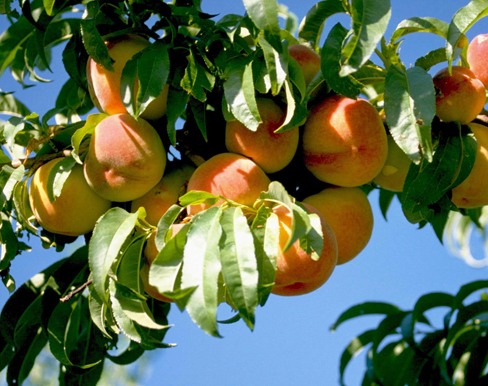Peaches
The peach (Prunus persica), which originated in China, is a member of the Rose family. In the past, commercial peach production in Kentucky has been profitable only in western counties, in southern counties, and in areas along the Ohio River. However, over the past 15 years as winters have become warmer, peach growers are also doing well in areas west of the mountains, as long as good sites that avoid late spring frosts are selected.
Marketing
Growers should determine
possible markets before planting. Most Kentucky peaches are sold to local customers at fresh market outlets, especially farmers markets, on-farm markets and roadside stands. Some peaches are sold by U-Pick or CSA-style, through direct deliveries to customers. Local grocers may feature Kentucky peaches, and some wholesale peaches move through Kentucky’s produce auctions. Producers can also investigate wholesaling to restaurants. Peaches are popular in value-added products such as ice cream, baked goods and preserves. Kentucky consumes more peaches than it produces, thus providing opportunities for additional peach production within the state. Peach acreage in Kentucky declined from 800 acres in 1992 to about 500 acres in 2012. The 2012 Ag Census indicated some increase in peach plantings, which may indicate ongoing demand for high quality locally produced commercial peaches in the Commonwealth.
Production
 Selecting hardy bacterial spot resistant cultivars that produce quality fruit, perform reliably, and meet the market demands is a critical step in establishing a peach planting. Peaches are grouped as either freestone (the flesh easily separates from the pit) or clingstone (the flesh clings to the pit). Cultivars differ in such horticultural traits as fruit (e.g. size, color, flavor and skin fuzziness), disease resistance, days to harvest, and required chilling hours. Many consumers prefer a high quality, flavorful freestone peach that is relatively fuzz-free. Selection of the orchard site is probably the most important single factor in peach production. Even in areas of the state generally recommended for peach production, the site must be chosen very carefully. The orchard should be considerably higher than surrounding areas, with good slopes suitable for air drainage. A gentle slope is ideal; however, if the site is terraced, a steeper slope can be used. Slopes should preferably face east, southeast or northeast. Avoid protected areas, such as near wood lots, since these obstruct air flow and allow frost pockets to form. Peaches do well on a wide variety of soil types; however, they will not tolerate heavy, poorly drained soils.
Selecting hardy bacterial spot resistant cultivars that produce quality fruit, perform reliably, and meet the market demands is a critical step in establishing a peach planting. Peaches are grouped as either freestone (the flesh easily separates from the pit) or clingstone (the flesh clings to the pit). Cultivars differ in such horticultural traits as fruit (e.g. size, color, flavor and skin fuzziness), disease resistance, days to harvest, and required chilling hours. Many consumers prefer a high quality, flavorful freestone peach that is relatively fuzz-free. Selection of the orchard site is probably the most important single factor in peach production. Even in areas of the state generally recommended for peach production, the site must be chosen very carefully. The orchard should be considerably higher than surrounding areas, with good slopes suitable for air drainage. A gentle slope is ideal; however, if the site is terraced, a steeper slope can be used. Slopes should preferably face east, southeast or northeast. Avoid protected areas, such as near wood lots, since these obstruct air flow and allow frost pockets to form. Peaches do well on a wide variety of soil types; however, they will not tolerate heavy, poorly drained soils.

